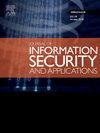UMANeT: A two-stage interpolation-based reversible data hiding framework with attention-enhanced prediction
IF 3.7
2区 计算机科学
Q2 COMPUTER SCIENCE, INFORMATION SYSTEMS
Journal of Information Security and Applications
Pub Date : 2025-09-13
DOI:10.1016/j.jisa.2025.104217
引用次数: 0
Abstract
Interpolation-based reversible data hiding (RDH) techniques have recently attracted significant attention due to their ability to enhance image resolution while ensuring secure data embedding. However, the effectiveness of these methods heavily depends on the quality of the interpolated cover images. Conventional interpolation techniques, typically based on linear models and limited local pixel contexts, often fail to generate high-quality cover images, thereby compromising the visual quality of the resulting stego images and limiting embedding capacity. To address these limitations, this paper introduces a novel hybrid interpolation framework that combines bicubic interpolation with a deep learning-based predictor to construct a high-fidelity two-stage interpolation mechanism. Central to this framework is a newly proposed predictor, termed UMANeT, which leverages a broader contextual region for improved pixel prediction accuracy. By effectively capturing non-linear and long-range dependencies, UMANeT enhances the overall image quality used for data embedding. Experimental results demonstrate that the proposed method not only achieves superior embedding capacity but also generates cover and stego images of significantly higher visual quality compared to existing interpolation-based RDH techniques.
UMANeT:一种基于两阶段插值的可逆数据隐藏框架,具有注意力增强预测
基于插值的可逆数据隐藏(RDH)技术由于能够在保证数据嵌入安全的同时提高图像分辨率而引起了人们的广泛关注。然而,这些方法的有效性在很大程度上取决于插值的覆盖图像的质量。传统的插值技术,通常基于线性模型和有限的局部像素上下文,往往不能产生高质量的覆盖图像,从而损害了所得到的隐写图像的视觉质量,并限制了嵌入能力。为了解决这些限制,本文引入了一种新的混合插值框架,该框架将双三次插值与基于深度学习的预测器相结合,构建了高保真的两阶段插值机制。该框架的核心是一个新提出的预测器,称为UMANeT,它利用更广泛的上下文区域来提高像素预测精度。通过有效捕获非线性和远程依赖关系,UMANeT提高了用于数据嵌入的整体图像质量。实验结果表明,与现有的基于插值的RDH技术相比,该方法不仅具有更好的嵌入能力,而且生成的覆盖和隐去图像的视觉质量也显著提高。
本文章由计算机程序翻译,如有差异,请以英文原文为准。
求助全文
约1分钟内获得全文
求助全文
来源期刊

Journal of Information Security and Applications
Computer Science-Computer Networks and Communications
CiteScore
10.90
自引率
5.40%
发文量
206
审稿时长
56 days
期刊介绍:
Journal of Information Security and Applications (JISA) focuses on the original research and practice-driven applications with relevance to information security and applications. JISA provides a common linkage between a vibrant scientific and research community and industry professionals by offering a clear view on modern problems and challenges in information security, as well as identifying promising scientific and "best-practice" solutions. JISA issues offer a balance between original research work and innovative industrial approaches by internationally renowned information security experts and researchers.
 求助内容:
求助内容: 应助结果提醒方式:
应助结果提醒方式:


